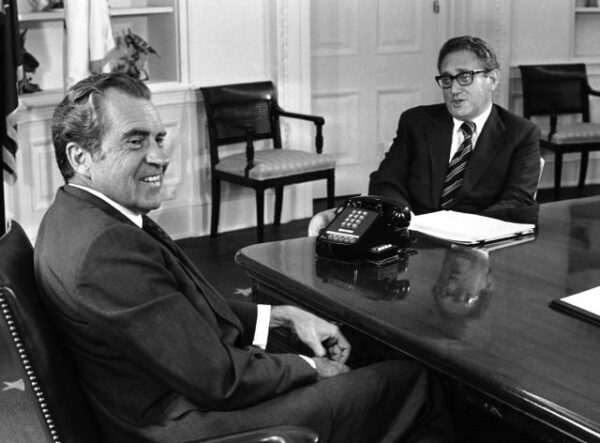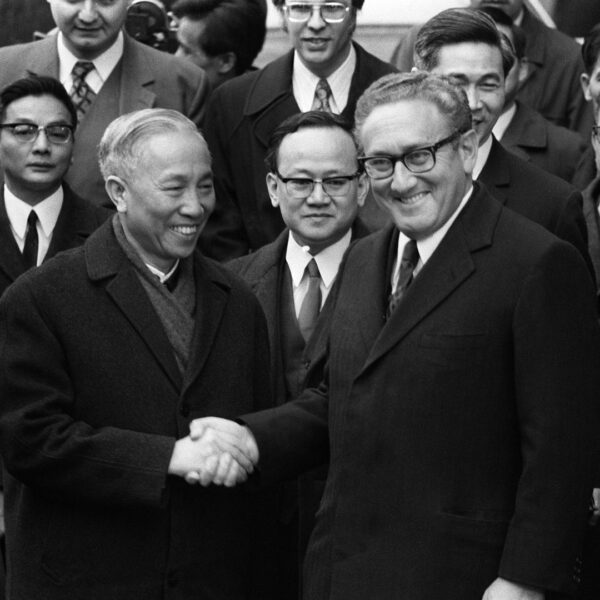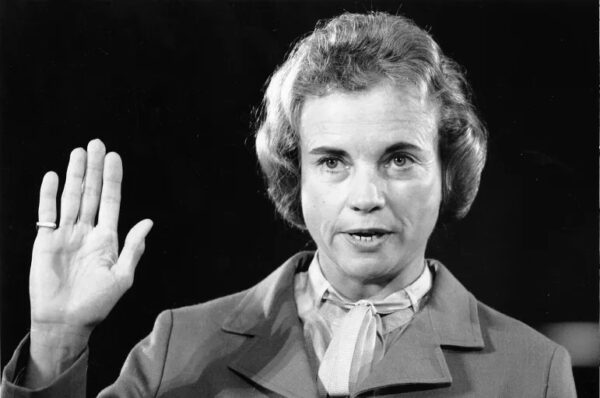
Two conservative icons recently passed within days of each other, as November rolled over to December 2023. On November 29, Henry Kissinger, former Secretary of State, propelled from academia into international prominence by Richard Nixon, instrumental in ending the Vietnam War and reestablishing diplomatic relations with Communist China, died at the age of 100. Two days later, on December 1, former Justice Sandra Day O’Connor, a Reagan appointee and the first woman to sit on the US Supreme Court, passed at age 93. While neither would recognize today’s Republican Party, so focused on grievance and retribution instead of policy, and both have serious blots on their legacies, each reminds us that there were once two viable political philosophies vying for control of the country, in a comparatively congenial and collegial atmosphere.
Those days seem as dated as Kissinger himself, still offering advice and counsel on the brink of his centennial. Born 27 May 1923 at 5:30 AM MET in Furth, Germany (Rodden Rating AA), Heinz Alfred Kissinger was ten when Adolph Hitler became Chancellor of Germany, and things began to deteriorate rapidly for Jewish families such as his. Harassed and beaten by members of the Hitler Youth, and refused admittance to the Gymnasium, the highest and most advanced of German secondary schools, when his father was driven from his job as a teacher, the family emigrated to the US in 1938 to avoid further persecution, settling in the German-Jewish community of Washington Heights in Manhattan.
After high school, Kissinger, now anglicized as “Henry,” entered the City College of New York, but was drafted into the US Army and became a naturalized US citizen at age 20. He remained a lowly private, but his proficiency in German made him a valuable asset when his native land was occupied, and he garnered an important management post, helping to establish a civilian administration of Germany.

After the war, Kissinger returned full-time to academic life, earning a Bachelor of Arts summa cum laude from Harvard in 1950; his major was political science. He went on to take a Masters and a Doctorate from Harvard, and began work in various conservative think tanks, eventually becoming foreign policy advisor to Nelson Rockefeller’s presidential nomination campaigns in the 1960s. On December 10, 1967, Kissinger’s life course changed dramatically when he met former Vice President Richard Nixon at a pre-holiday cocktail party at the home of Clare Booth Luce, a writer and former congressperson and US Ambassador to Italy. Initially uncertain of Nixon’s suitability to serve, he became an avid supporter after the latter received the Republican nomination in 1968.
Following Nixon’s victory, Kissinger served as National Security Advisor in the first term, and was appointed as Secretary of State at the start of the second term in 1973, remaining in that capacity for Gerald Ford after Nixon’s resignation in disgrace in 1974. An avid proponent of Realpolitik, which emphasizes practical considerations over moral or ideological stances, Kissinger pushed the policies of détente which eased Cold War tensions with the Soviet Union and allowed the restoration of diplomatic relations with Communist China.
But he was also instrumental in expanding the Vietnam War into neighboring Cambodia, as a way of putting pressure to negotiate a diplomatic settlement with the Viet Cong, represented by Le Duc Tho, with whom he shared a Nobel Peace Prize in 1973. A mooted ceasefire and withdrawal of US troops in exchange for release of American POWs came to nothing, and the war dragged on another two years.
Focused on Southeast Asia, Kissinger failed to defuse other international crises, such as the 1973 Yom Kippur War between Israel and an Arab coalition led by Egypt and Syria, the Turkish invasion of Cyprus in 1974, and the Indonesian occupation of East Timor in 1975. Reaction to his Middle East policies resulted in a Saudi oil embargo which sent the US economy into a tailspin in 1973, with gas prices spiking inflation and long lines at pumping stations.
After Jimmy Carter’s defeat of Gerald Ford in 1976, Kissinger was out of a job, and took a teaching position at Georgetown University, followed by establishing his own consulting firm and ongoing work for a variety of conservative policy foundations. He never held public office again, but continued to be influential in the conservative movement, offering advice to Republican administrations and making public statements on current events, solicited or otherwise, right up to the Israel-Hamas War in October 2023, just a month before his death.
Asteroid Henry 1516 appears at 23 Aries, closely opposed the 22 Libra Moon, a common placement for one’s own PNA (Personal-Named Asteroid), typically tied to the Sun, Moon or Ascendant. This polarity forms the spine of a Grand Trine Kite pattern with the Moon at its String, the associated points being asteroids Karma 3811 at 22 Sagittarius (itself exactly on the Descendant, indicating angular importance of Fate in his life) and Richard 3972 at 23 Leo, exactly trine Henry. This binds Henry Kissinger and Richard Nixon in a fated relationship, driven by the Moon (the public) in diplomacy-minded Libra.
Henry also conjoins asteroid Atropos 273 at 29 Aries, and squares asteroid Rip 7711 at 22 Capricorn. Atropos is named for the mythic Greek Fate who severs the thread of life at death, while Rip also acts as a death indicator in the form of the acronym RIP, “Rest In Peace”, a common tombstone inscription. Henry Kissinger thereby had a strong connection to the theme of death, and certainly the decision to broaden the Vietnam War into Cambodia, which he endorsed and lobbied for, massively increased the carnage from that conflict.
The 4 Gemini Sun conjunct Mercury at 7 Gemini portrays his intellect and education, and lies at the Apex of a Yod pattern, AKA Finger of Destiny, with inconjunct aspects to Jupiter at 11 Scorpio and asteroid Hanoi 7816 at 5 Capricorn. Jupiter shows the importance of religion and politics in his biography; his Jewish heritage was the proximate cause of his family’s emigration to the US, where his natural abilities could flourish. It also governs foreign policy, Kissinger’s main focus professionally, as National Security advisor, Secretary of State, and consultant. Hanoi is named for the capital of North Vietnam, the state which absorbed so much of Kissinger’s time, energy and diplomatic focus.

Another indicator of the importance of the Asian sphere is the Sun’s square to asteroid China 1125 at 5 Pisces, indicating conflict and strain, but also evoking a great deal of energy, and a personal stake (Sun) in the challenges (square) posed by the communist monolith (China). A sextile from China to Venus at 6 Taurus suggests the breakout philosophy of détente, aiming to end decades of Chinese isolation on the world stage.
The Sun also conjoins asteroid Nancy 2056 at 11 Gemini, here representing his second wife, Nancy Maginnis, to whom he was married for almost 50 years. Asteroid connections to the Sun denote persons who are pivotal in the biography, for good or ill. The couple were famously mismatched physically, with the robust, 6’ tall Nancy towering over her slight, 5’ 8” husband, creating a humorous image. Nancy, 11 years his junior, survives him.
There is one body at station in Kissinger’s birth chart, with these still points representing vital factors in the life and biography. This is asteroid Whitehouse 4036 at 11 Aquarius, trine the Sun, which turned retrograde on June 3, 1923. The importance of Kissinger’s connection to the US presidency, symbolized by this point, cannot be overstated, both for himself and the nation and world at large.
When Henry Kissinger passed away at his home in Kent, Connecticut on 29 November 2023, transit asteroid Kent 28346 at 4 Pisces conjoined transit Saturn, ancient lord of death, at 1 Pisces, and was exactly squared the natal Sun at 4 Gemini. An eventual death in Kent is prefigured by natal Kent at 6 Pisces opposed natal asteroid Anubis 1912 at 5 Virgo, named for the Egyptian deity governing funerary rites, T-Squared the Sun. Note that at his death, transit Kent was about to return to its natal degree, reinforcing that potential, with transit Saturn as an enforcer of that likelihood.
Transit asteroid Henry at 14 Sagittarius conjoined the transit Sun at 7 Sagittarius, placing Kissinger in the spotlight one last time. Transit asteroid Osiris 1923 at 4 Sagittarius, named for the Egyptian god of the dead, also conjunct the transit Sun, exactly opposed the natal Sun.

Transit asteroid Lachesis 120, named for the Fate who determines the span of life, is at station from 16 Aries, about to turn direct a week later, and squares natal asteroid Rip at 22 Capricorn, itself also conjoined by transit asteroid Requiem 2254 at 18 Capricorn, named for the funeral mass for the dead.
Transit Atropos at 14 Taurus with transit Jupiter at 7 Taurus denotes a celebrity (Jupiter) death (Atropos), and exactly opposes transit Rip at 14 Scorpio, forming a T-Square with natal Requiem at 16 Aquarius. Transit Pluto at 28 Capricorn, modern lord of death, closely squares natal Atropos at 29 Aries, while transit Anubis at 26 Sagittarius aligns with the natal Karma/Descendant conjunction at 22 Sagittarius, exactly opposing natal asteroid Nemesis 128 at 26 Gemini (a point of ruin or destruction) on the 22 Gemini Ascendant, signaling that Henry Kissinger’s time had come.
Sandra Day O’Connor’s law career got off to a slow start; after graduation from Stanford Law School in 1952, she was unable to find employment, due to her gender. She eventually accepted an unpaid position as deputy county attorney in San Mateo, California, with no salary and not even her own office, sharing space with a secretary. How ironic, then, that she should emerge as the first woman to sit on the US Supreme Court, some 30 years later.
After proving herself for a few months, O’Connor began to earn a small salary, but left to follow her husband John when he was drafted as a civilian attorney for the US Army in Germany. Upon their return to the Sates, the young family settled in Maricopa County, Arizona, where O’Connor went on to work for Barry Goldwater’s 1964 presidential campaign, then served as Arizona’s assistant Attorney General from 1965-69. In that year she was appointed to fill a vacancy in the Arizona State Senate, and won the seat outright in 1970.
In 1974 she was appointed to the Maricopa County Supreme Court, then ascended to the Arizona State Court of Appeals in 1979, where she was serving when Ronald Reagan came knocking in1981. O’Connor’s nomination to the US Supreme Court as its first female member fulfilled a Reagan campaign pledge to appoint a woman, but her elevation did not come without controversy from ultra-conservative religious leaders, who objected to her moderate stance on abortion. Nevertheless, O’Connor sailed through her Senate vote, achieving confirmation by 99-0 on 21 September 1981. It’s difficult to conceive of that level of bipartisan support today, for anyone or any issue.
O’Connor was a reliable vote for the conservative bloc on the Court, supporting such decisions as Grutter v Bollinger, which alleged “reverse discrimination” against prospective white students in the University of Michigan’s undergraduate admissions process; Lockyer v Andrade, which held that a 50-year-to-life sentence without parole for petty shoplifting was not “cruel and unusual punishment”; Zelman v Simmons-Harris, which stated that the use of school vouchers for religious schools did not violate the Establishment Clause of the First Amendment; and United States v Lopez, which declared the Gun-Free School Zones Act to be unconstitutional.

But O’Connor truly blotted her copybook with the controversial Bush v Gore decision in 2000, which stopped the Florida recount process and essentially declared George W. Bush the next US President. O’Connor joined the conservative majority in defending individual rights over state’s rights, a total reversal of the typical conservative mindset (though, to be fair, the progressive members of the Court likewise reversed themselves philosophically to support Gore). At the time, O’Connor expressed surprise that the decision caused such an uproar, but in 2013, seven years after her retirement, she opined that perhaps for the good of the Court, it would have been better not to have taken the case at all, since the decision gave the SCOTUS a “less than perfect reputation.”
In addition to the politics of the situation, her decision on Bush v Gore may have had a personal motivation, with O’Connor seeking to retire and loathe to do so under a Democratic administration which would fill her seat with a progressive. Regardless of Bush’s victory, O’Connor delayed retirement a further five years, until his second term, but a series of circumstances, including the death of Chief Justice William Rehnquist, when Bush pulled John Roberts as his nominee for her seat and elevated him to fill Rehnquist’s post, pushed off her return to Arizona until 2006.
After retirement, O’Connor pursued public speaking and issues advocacy, briefly teaching a course on the Supreme Court at the University of Arizona’s James E. Rogers College of Law. In 2009 she launched Our Courts, a website devoted to educating young people about the role of civics and government in our society, a knowledge she found sadly lacking.
After 2013 O’Connor’s mental state and physical health both began to decline. She was confined to a wheelchair and moved into an assisted living facility in 2017, where she died on 1 December 2023, due to complications from advanced dementia and respiratory illness. She will lie in state in the Great Hall of the US Supreme Court on December 18th.

Born 26 March 1930 at 1:10 AM MST in El Paso, Texas (Rodden Rating AA), Sandra Day O’Connor’s lifepath seems laid out before her by the stars, with asteroid Justitia 269, named for the Roman goddess of justice and the root of our word, conjoined the 4 Aries Sun from 10 Aries. As well asteroid Themis 24 at 4 Cancer, named for her Greek counterpart, appears in a powerful angular position conjunct the 3 Cancer Descendant, exactly squared her Sun. Given this, it’s perhaps no surprise that her job title was Justice for 25 years.
The Sun also conjoins Mercury at 28 Pisces and Uranus at 10 Aries, which one might speculate would cultivate a more progressive (Uranus) judicial (Justitia) philosophy (Mercury). But Uranus is counterbalanced by Saturn, ruler of conservatism, which at 11 Capricorn squares the solar stellium and also conjoins the 3 Capricorn Ascendant, another indicator of a traditionalist or conventional (Saturn) public image (Ascendant). Uranus/Justitia further conjoins Venus at 16 Aries, and it is the areas of women’s health and rights where O’Connor strayed most frequently from towing the party line.
Asteroid Sandra 1760 at 1 Aries also conjoins the Sun; again, as with Kissinger, this is a common placement for one’s own PNA. Asteroid O’Connor 8357 at 11 Scorpio squares the Moon at 20 Aquarius, also common. Its participation in a Grand Trine Kite pattern, trine to Themis at 4 Cancer and Mars at 7 Pisces, with the String formed by Themis opposition to Saturn, affirm her (O’Connor) as a leader and advocate (Mars) for conservative (Saturn) jurisprudence (Themis).
Sandra Day O’Connor’s Senate confirmation as the first female Justice of the SCOTUS on 21 September 1981 is appropriately reflected in the heavens, with a conjunction of asteroid Themis (Justice) at 7 Scorpio and Venus (women) at 10 Scorpio, squared asteroid Senator 8603) at 5 Leo. Asteroid Sandra at 7 Gemini is exactly inconjunct Themis, while asteroid O’Connor at 23 Libra is an exact match for Pluto, indicating the immense increase in personal power for O’Connor, with Jupiter also conjoined from 15 Libra, ruling the judiciary generally and the Supreme Court specifically. Also here is Mercury at 24 Libra, suggesting the newsworthiness of the event, which transformed (Pluto) the Court (Jupiter) from an exclusive XY chromosome club. The Libran stellium is also trine asteroid Themis at 24 Gemini, which itself squares the Sun with asteroid Washingtonia at 28 and 24 Virgo, spotlighting (Sun) the venue (Washingtonia) for her confirmation as Justice (Themis).

When Sandra Day O’Connor passed on 1 December 2023, transit asteroid Sandra at 22 Sagittarius aligned with transit asteroid Anubis at 27 Sagittarius, squared transit Neptune at 24 Pisces and natal asteroid Osiris at 29 Pisces. This links O’Connor personally (Sandra) with both transit and natal death indicators (Anubis, Osiris), as well as the planet ruling dementia (Neptune), a leading cause in her demise.
Transit asteroid O’Connor at 16 Aquarius squares transit asteroid Rip at 15 Scorpio and opposes a stationary asteroid Nemesis at 8 Leo, which would turn retrograde two days later, and also conjoins natal asteroid Anubis at 10 Aquarius. Again we see the combination of a PNA (O’Connor) with both transit and natal markers of passing (Rip, Anubis) and a point representing ruin or destruction (Nemesis). The addition of asteroids Atropos and Justitia at 14 and 22 Taurus creates a Grand Cross, emphasizing the death (Atropos) of a former SCOTUS Justice (Justitia). Transit Saturn at 1 Pisces, ancient lord of death, conjoins natal Atropos at 29 Aquarius and exactly opposes natal Neptune at 1 Virgo, again reflecting dementia (Neptune) as a leading cause of death (Saturn). Transit Pluto at 28 Capricorn, modern lord of death, squares natal asteroid Rip at 27 Aries.

As more and more of the Old Guard passes, America faces a crisis of leadership, a political landscape bleakened by self-interest, incompetence, venality and heightened partisan vituperation. If we can’t disagree without being disagreeable, can’t dispute without invective, can’t even contemplate compromise and concession, what hope remains for our democracy?
Alex Miller is a professional writer and astrologer, whose website AlexAsteroidAstrology.com offers a trove of info on the role of asteroids in personal and mundane astrology. He is the author of The Black Hole Book (available on Amazon.com) and The Urban Wicca, former editor of “The Galactic Calendar,” and past president of The Philadelphia Astrological Society. His pioneering work with Black Holes in astrological interpretation began in 1991, when his progressed Sun unwittingly fell into one. Alex’s books and writings are available on his website. Alex can also be reached for comment or services at .
Leave a Reply